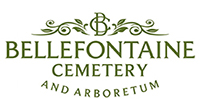As the cemetery management practices evolve to become more sustainable, Bellefontaine has been cultivating partnerships with organizations to study and enhance the biodiversity on the cemetery grounds. Our first partnership began with The Audubon Center at Riverlands in 2013. Its purpose was to conduct a two year bird count to determine which migratory species are using the cemetery grounds for nesting, resting and food. As the bird population is studied, scientists with Audubon have recommended native plants that will attract additional birds by providing them with the forage or cover they need during their travels.
As a result of the recommendations, the cemetery partnered with the Missouri Department of Conservation to create native habitat planting beds scattered throughout the property. The cemetery received a grant to convert sixteen planting beds from non-native plant species to plants that will attract wildlife. These include perennials such as asters, coneflowers, goldenrod and milkweed; and shrubs mock orange, sand cherry and currant.
To further enhance the cemetery’s biodiversity, this summer we partnered with the Harris World Ecology Center at the University of Missouri St. Louis (UMSL). The Harris Center “promotes research and training in basic ecology and biodiversity conservation across the globe, and increases public awareness and interest in issues relating to global natural resource conservation.” In early August, the Harris Center sponsored a nighttime bat and moth sampling to see what kind of night creatures the cemetery hosts. Red bats and large brown bats were captured, documented and released.

Horticultural staff and volunteers planted a butterfly garden as part of St. Louis Mayor Slay’s “Milkweeds for Monarchs” initiative. St. Louis is located along the monarch’s migratory route between Mexico and North America. With the monarch population rapidly dwindling, we want to support efforts to increase the population by providing important food sources for them. Twelve species of milkweed – the sole food source for the caterpillars – were planted in the garden. The Harris Center has also provided a graduate student intern to photograph and survey butterflies at the cemetery. This will help us understand if our efforts to attract butterflies and other pollinators are successful.

The cemetery’s efforts to increase biodiversity are in the interest of protecting and enhancing our urban oasis. Our goal is to enhance the beauty and diversity of life on the grounds for the benefit and enjoyment of many generations to come.

Post a comment